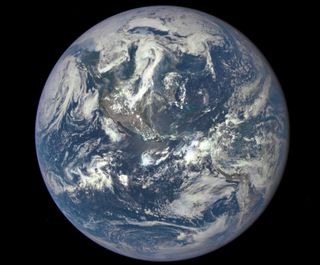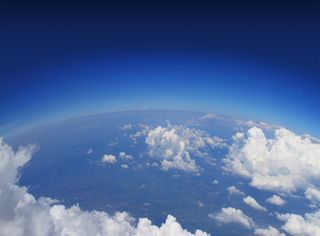7 Ways to Prove the Earth Is Round (Without Launching a Satellite)
Proving Earth is round

Rapper B.o.B wants to crowdfund his own satellite and launch it into space to find out, once and for all, whether the Earth is flat or round. As a flat-Earth conspiracy theorist, the Georgia-based musician is betting on flat, but his $1 million call for cash on GoFundMe has raised only about $2,000 in its first five days, the first $1,000 pledged by B.o.B himself.
Fortunately, there are plenty of cheaper ways than a satellite launch to show that the Earth is round. In the spirit of scientific inquiry, here are seven.
Go to the harbor

When a ship sails off toward the horizon, it doesn't just get smaller and smaller until it's not visible anymore. Instead, the hull seems to sink below the horizon first, then the mast. When ships return from sea, the sequence is reversed: First the mast, then the hull, seem to rise over the horizon.
The ship-and-horizon observation is so self-evident that 1881's "Zetetic Astronomy," the first modern flat-Earth text, devotes a chapter to "debunking" it. The explanation relies on assuming that the sequential disappearance is simply an illusion brought on by perspective. This debunking does not make much sense, however, as there's nothing about perspective (which just says that things are smaller over longer distances) that should make the bottom of an object disappear before the top. If you'd like to prove to yourself that perspective isn't the reason for boats disappearing hull-first and returning mast-first, bring a telescope or binoculars on your trip to the harbor. Even with vision enhancement, the ship will still dip below the curve of the Earth.
Look at the stars

Greek philosopher Aristotle figured out this one in 350 B.C., and nothing's changed. Different constellations are visible from different latitudes. Probably the two most striking examples are the Big Dipper and the Southern Cross. The Big Dipper, a set of seven stars that looks like a ladle, is always visible at latitudes of 41 degrees North or higher. Below 25 degrees South, you can't see it at all. And in northern Australia, just north of that latitude, the Big Dipper just barely squeaks above the horizon.
Meanwhile, in the Southern Hemisphere, there's the Southern Cross, a bright four-star arrangement. That constellation isn't visible until you travel as far south as the Florida Keys in the Northern Hemisphere.
These different stellar views make sense if you imagine the Earth as a globe, so that looking "up" really means looking toward a different sliver of space from the Southern or Northern hemisphere.
Watch an eclipse

Aristotle also bolstered his belief in a round Earth with the observation that during lunar eclipses, the Earth's shadow on the face of the sun is curved. Since this curved shape exists during all lunar eclipses, despite the fact that Earth is rotating, Aristotle correctly intuited from this curved shadow that the Earth is curvy all around — in other words, a sphere.
For that matter, solar eclipses also tend to bolster the idea that the planets, moons and stars are a bunch of roundish objects orbiting each other. If the Earth is a disk and the stars and planets a bunch of small, nearby objects hovering in a dome above the surface, as many flat-Earthers believe, the total solar eclipse that crossed North America in August 2017 becomes very difficult to explain.
Go climb a tree

This is another one of those self-evident things: You can see farther if you go higher. If the Earth was flat, you'd be able to see the same distance no matter your elevation. Think about it: Your eye can detect a bright object, like the Andromeda galaxy, from 2.6 million light-years away. Seeing the lights of, say, Miami from New York City (a distance of a mere 1,094 miles or 1,760 kilometers) on a clear evening should be child's play.
But it's not. That's because the curvature of the Earth limits our sight to about 3.1 miles (5 kilometers) … unless you climb up a tall tree, building or mountain and get yourself a perspective from higher up.
Take a round-the-world flight

This one should cost you considerably less than $1 million, though you will have to drop a few thousand dollars. Anyone can circumnavigate the globe nowadays; there are even travel firms, like AirTreks, that specialize in multi-stop, round-the-world routes. You won't have to retrace your steps to land where you started.
If you get lucky enough to get an unobscured view of the horizon and a high enough commercial flight, you might even be able to make out the curvature of the Earth with the naked eye. According to a 2008 paper in the journal Applied Optics, the Earth's curve becomes subtly visible at an altitude of around 35,000 feet, as long as the observer has at least a 60 degree field of view (which may be difficult from a passenger plane window). The curvature becomes more readily apparent above 50,000 feet; passengers on the now-grounded supersonic Concorde jet were often treated to a view of the curved horizon while flying at 60,000 feet.
Get a weather balloon

In January 2017, University of Leicester students strapped some cameras to a weather balloon and sent it skyward. The balloon rose 77,429 feet (23.6 kilometers) above the surface, well above the level needed to view the planet's curves. The instrument aboard the balloon sent back stunning footage that shows the curve of the horizon.
As long as your balloon has a payload of less than four pounds, there are hardly any restrictions on launching it. Just call the Federal Aviation Administration ahead of time to make sure you're not headed into restricted airspace.
Compare shadows

The first person to estimate the circumference of the Earth was a Greek mathematician named Eratosthenes, who was born in 276 B.C. He did so by comparing shadows case on the day of the summer solstice in what is today Aswan, Egypt, with the more northerly city of Alexandria. At noon, when the sun was directly overhead in Aswan, there were no shadows. In Alexandria, a stick set in the ground cast a shadow. Eratosthenes realized that if he knew the angle of the shadow and the distance between the cities, he could calculate the circumference of the globe.
On a flat Earth, there wouldn't have been any difference between the length of the shadows at all. The sun's position would be the same, relative to the ground. Only a globe-shaped planet explains why the sun's position should be different in two cities a few hundred miles apart.
Sign up for the Live Science daily newsletter now
Get the world’s most fascinating discoveries delivered straight to your inbox.

Stephanie Pappas is a contributing writer for Live Science, covering topics ranging from geoscience to archaeology to the human brain and behavior. She was previously a senior writer for Live Science but is now a freelancer based in Denver, Colorado, and regularly contributes to Scientific American and The Monitor, the monthly magazine of the American Psychological Association. Stephanie received a bachelor's degree in psychology from the University of South Carolina and a graduate certificate in science communication from the University of California, Santa Cruz.
